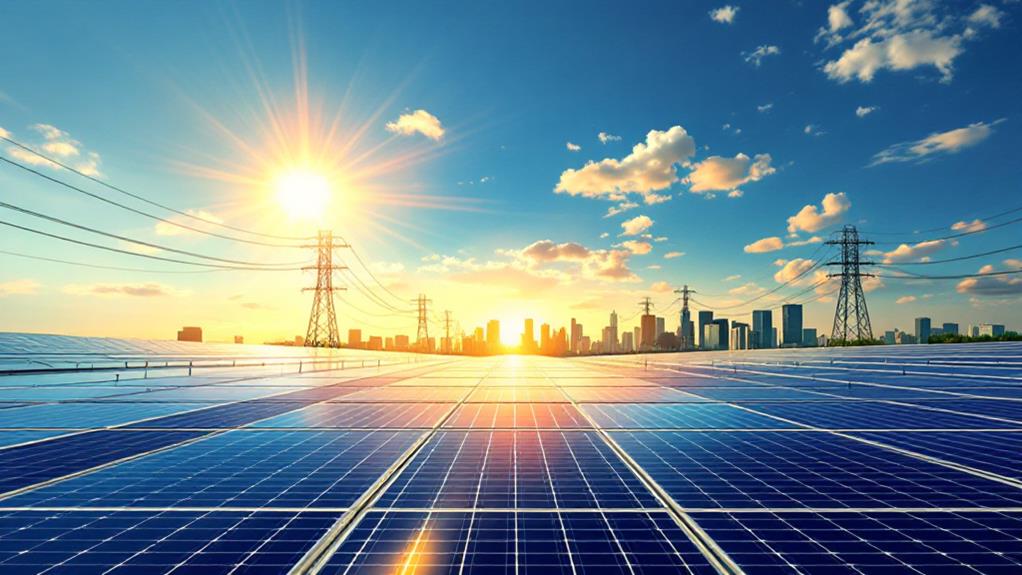How Many Solar Panels Are Needed to Power a Computer?
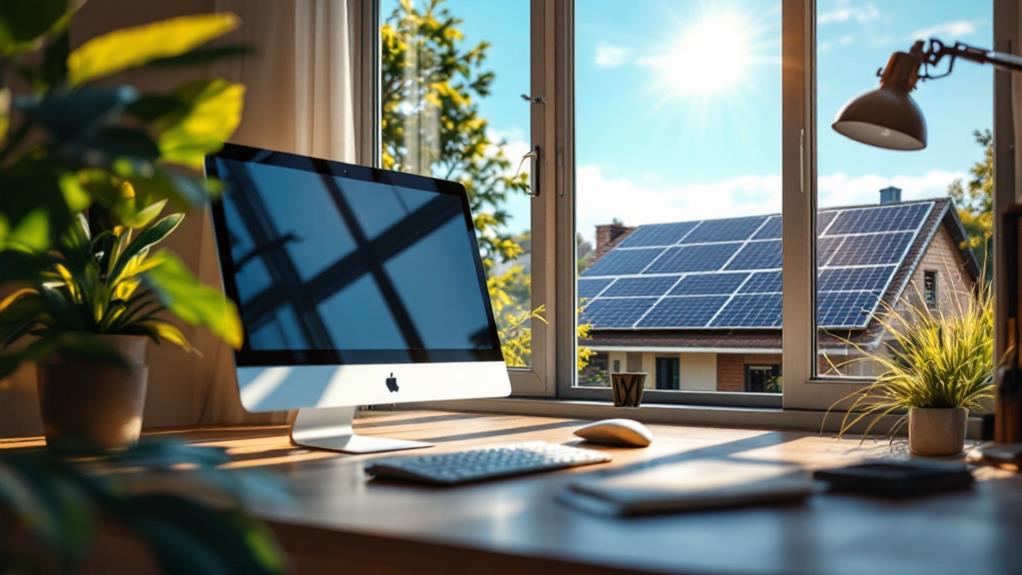
To power your computer with solar panels, initially determine its energy consumption. Laptops typically use around 60 watts, while desktops can use 300 watts or more. Calculate your daily power usage in watt-hours by multiplying the wattage by the hours of use. Choose suitable solar panels—monocrystalline panels are efficient but pricey, while polycrystalline are affordable yet less efficient. Estimate the number of panels by dividing your daily energy needs by a panel's wattage rating and consider geographic factors like sunlight exposure. Interested in fine-tuning your setup for peak performance and efficiency? There's a lot you can optimize here.
Understanding Computer Energy Requirements
To determine how many solar panels you need to power a computer, you initially have to understand the computer's energy requirements. It's essential to know how much power your computer consumes, which varies depending on the type and usage. Typically, a desktop computer has a higher energy consumption than a laptop. This difference is primarily due to the computer wattage, which indicates how much electricity the device uses.
First, check your computer's specifications or the power supply unit to find the wattage. The computer wattage will usually range from 60 watts for laptops to about 300 watts or more for desktops. For a more precise figure, you might use a power meter to measure the actual energy consumption while the computer is running typical tasks.
Calculating Daily Power Usage
Once you've identified your computer's energy requirements, it's time to calculate its daily power usage. Start by determining how many hours you use your computer daily. Multiply this number by the computer's power consumption, usually measured in watts. If your computer consumes 100 watts and you use it for eight hours a day, the daily power usage is 800 watt-hours (Wh).
Next, consider your computer's energy efficiency. Some computers use power more efficiently than others, thanks to features like low-energy processors or power-saving modes. If your computer has these, you might reduce its power consumption by up to 20%. For instance, applying a 20% reduction to your 800 Wh results in a more efficient usage of 640 Wh per day.
Additionally, consider peripherals like monitors, printers, and external drives that might add to your total power consumption. Calculate their combined usage correspondingly and add it to your computer's power usage for an accurate total. By understanding the daily power usage, you'll have a clearer picture of your energy needs, allowing you to plan effectively for sustainable energy solutions like solar panels. This knowledge helps guarantee you're not only meeting your power needs but also optimizing energy efficiency.
Solar Panel Basics
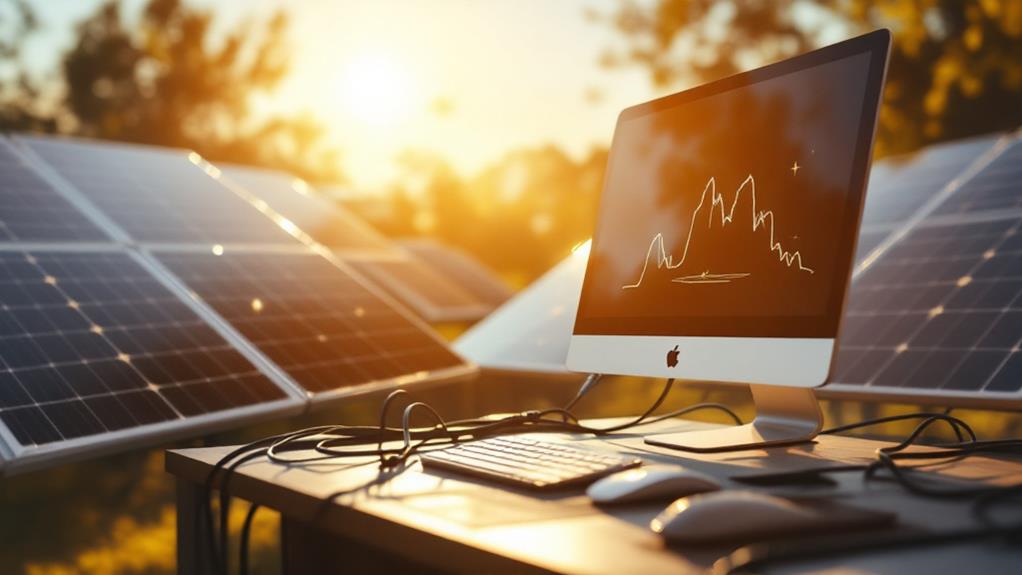
Harnessing solar energy can markedly reduce your reliance on traditional power sources. Understanding the basics of solar panels is crucial if you're considering this renewable option for powering a computer. Initially, familiarize yourself with the different solar panel types. The three main types are:
- Monocrystalline panels: These are known for high efficiency and longevity. They're made from a single, pure crystal structure.
- Polycrystalline panels: These are generally less efficient than monocrystalline panels but are more affordable due to their simpler manufacturing process.
- Thin-film panels: These offer flexibility and are lightweight, making them easier to install, but they typically have lower efficiency.
Furthermore, consider the installation methods. Proper installation is critical to enhance sunlight exposure and energy capture. Panels can be mounted on rooftops, integrated into building materials, or placed on the ground. Each method has its pros and cons. Rooftop installations save space but may require additional structural support. Ground-mounted systems are easier to access for maintenance but need ample land.
Factors Affecting Solar Efficiency
Several factors can greatly impact the efficiency of your solar panels. Initially, the type of solar panel materials considerably influences performance. High-quality materials lead to better efficiency ratings, meaning more electricity from the same amount of sunlight. You'll want to take this into account when selecting panels.
Environmental conditions are another vital aspect. Factors like temperature fluctuations and shading effects can drastically reduce efficiency. Ideally, your panels should be in a location with consistent sunlight and minimal shading. Even a small shadow from a tree or building can noticeably cut output.
The installation angle also matters. Panels should ideally be angled to capture maximum sunlight throughout the day. Adjusting this angle according to your geographic location can improve efficiency.
Don't overlook maintenance practices. Regular cleaning and inspections guarantee that dirt and debris don't block sunlight, maintaining peak efficiency.
Estimating Solar Panel Output
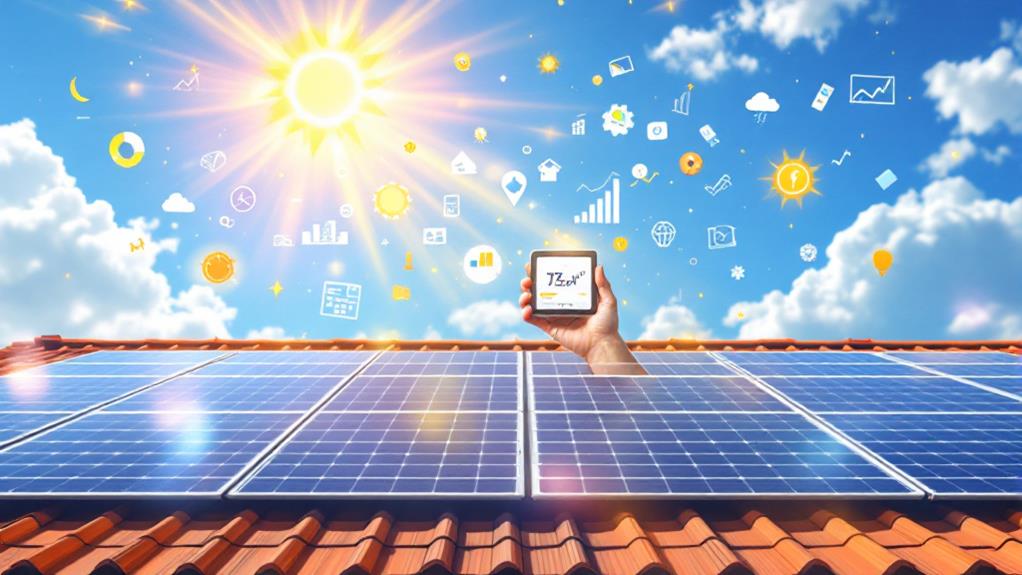
Understanding the output of your solar panels is crucial for determining how many you'll need to power a computer. To estimate this output, you initially need to evaluate the type of solar panels you're using. Different solar panel types, like monocrystalline, polycrystalline, and thin-film, have varying efficiency rates and energy conversion capabilities. Monocrystalline panels are often more efficient, converting more sunlight into electricity, but they might cost more.
Next, calculate the energy conversion rate. This tells you how much of the sunlight hitting your panels is converted into usable electricity. You must assess the wattage rating of your panels, which indicates the maximum power output under ideal conditions.
Here's a simple way to estimate:
- Determine your computer's energy needs: Check the wattage the computer uses to know how much energy you'll need.
- Check the solar panel's wattage: This helps you know how much power each panel can generate.
- Calculate the number of panels: Divide the computer's energy needs by the solar panel's wattage to find out how many panels you need.
Geographic Impact on Solar Power
When considering solar power for your computer, geographic location plays a significant role in determining the system's efficiency. Different areas receive varying amounts of sunlight due to solar irradiance variations. If you're living in a region with high solar irradiance, such as the southwestern United States, you'll likely need fewer solar panels to power your computer compared to someone living in a less sunny area like the Pacific Northwest.
Regional climate influence also affects how well your solar panels perform. Cloud cover, temperature, and weather patterns can all impact the energy generated. For instance, frequent cloudy days can reduce the amount of sunlight reaching your panels, decreasing their output. However, cooler temperatures often improve a solar panel's efficiency, countering some losses from less sunlight.
Understanding these factors is vital when planning a solar-powered setup for your computer. You should research local solar irradiance and climate conditions to accurately assess your solar panel needs. By doing so, you can optimize your solar power system to guarantee it meets your computer's energy requirements efficiently, no matter where you are. Remember, geographic considerations are key to maximizing your system's performance.
Sizing Your Solar Setup
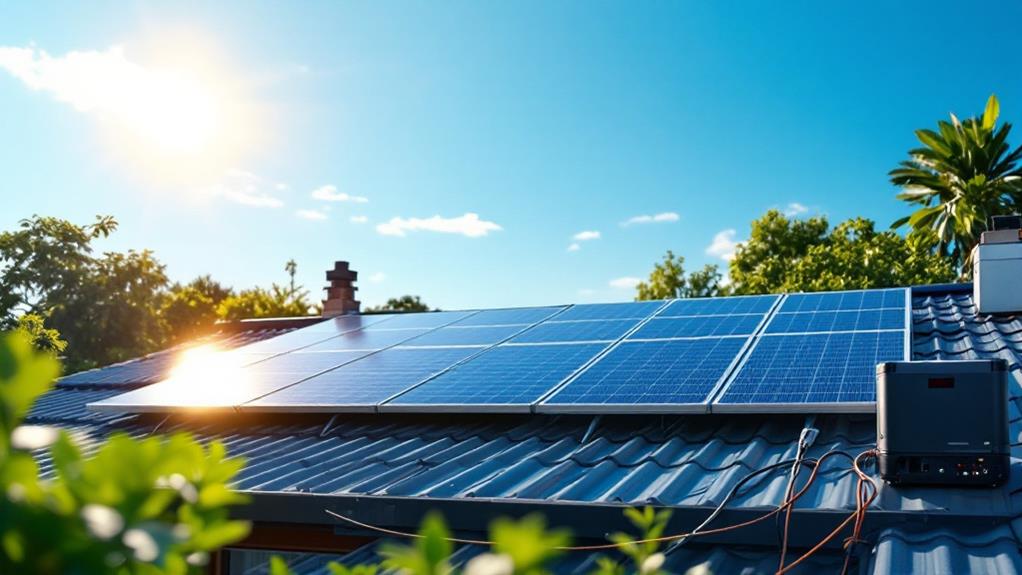
After considering how geography affects solar power efficiency, it's time to focus on sizing your solar setup. Determining the right number of solar panels involves understanding your computer's power consumption and choosing the appropriate solar panel types. Start by checking your computer's wattage. Most computers require between 60 to 250 watts, depending on the model and usage.
Here's a simple guide to help you size your solar setup:
- Calculate Power Needs: Determine your computer's daily energy usage in kilowatt-hours (kWh). Multiply the wattage by the number of hours you use it each day, then divide by 1000.
- Choose Solar Panel Types: Consider panel types like monocrystalline, polycrystalline, or thin-film. Monocrystalline panels are more efficient but cost more. Polycrystalline panels are cheaper but less efficient. Thin-film panels are flexible and easy to install, ideal for portable setups.
- Factor Installation Costs: Remember, installation costs can vary. Professional installation guarantees efficiency but adds to upfront expenses. DIY setups can save money, but require some technical know-how.
Battery Storage Considerations
Considering your solar setup's battery storage is crucial for ensuring a reliable power supply when the sun isn't shining. You need to think about battery capacity to make sure it meets your computer's energy demands. If your computer consumes 100 watts per hour and you plan to use it for five hours without sunlight, your battery should store at least 500 watt-hours. This calculation helps you understand the minimum battery capacity required.
Energy management is another vital aspect. It's about how efficiently you use and store energy. Installing a charge controller can help prevent overcharging and extend the battery's life. You'll want to monitor your energy usage closely to optimize the battery's performance. Consider using energy-efficient components, like LED monitors, to reduce total consumption.
Additionally, choose a battery type that suits your needs. Lithium-ion batteries, for instance, offer high efficiency and long lifespans but tend to be pricier. Lead-acid batteries are more affordable but require regular maintenance. Weigh these options carefully to find the right balance between cost and performance, ensuring your computer stays powered even when the sun isn't cooperating.
Practical Tips for Implementation
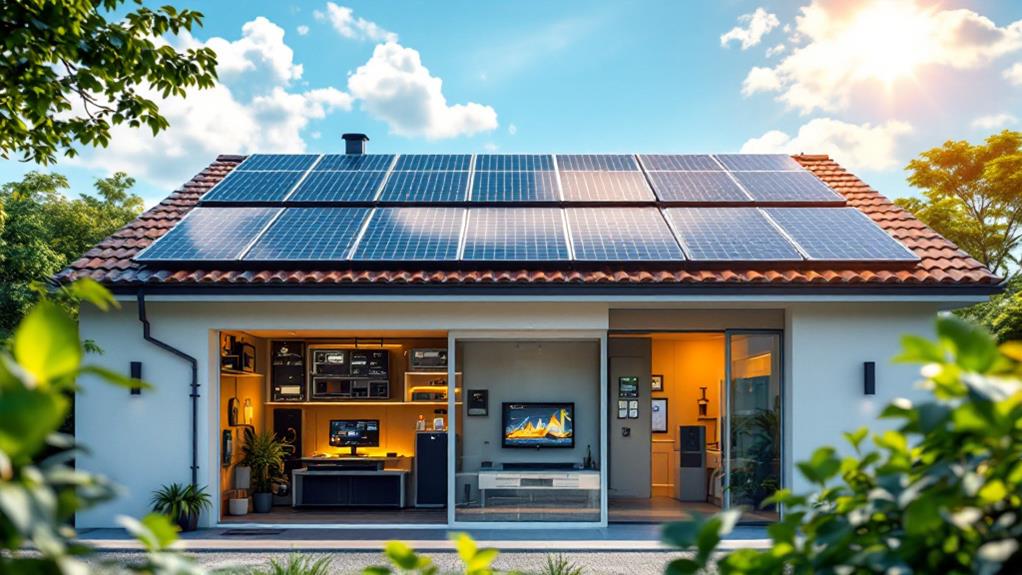
Implementing a solar setup to power your computer can be straightforward if you follow some practical tips. Start by choosing the right solar panel types. Monocrystalline panels are efficient and space-saving, making them ideal if you've got limited space. Polycrystalline panels are a cost-effective option for larger areas. Next, focus on installation techniques to guarantee your setup works at peak performance.
Key Tips for Implementation
- Select the Right Location: Place your panels in a spot that gets the most sunlight throughout the day. Avoid areas that have shade from trees or buildings, which can reduce the panels' efficiency.
- Adjust the Angle: Install your panels at an angle that matches your geographic latitude for best sun exposure. Use adjustable mounts to tweak the angle seasonally and enhance energy collection.
- Verify Proper Wiring: Use high-quality wiring and connectors to minimize energy loss. Make sure all connections are secure and protected from weather elements to avoid short circuits or power loss.

